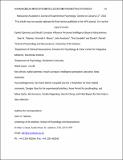Files in this item
Eyelid-openness and mouth curvature influence perceived intelligence beyond attractiveness
Item metadata
| dc.contributor.author | Talamas, Sean | |
| dc.contributor.author | Mavor, Kenneth Ian | |
| dc.contributor.author | Axelsson, John | |
| dc.contributor.author | Sundelin, Tina | |
| dc.contributor.author | Perrett, David Ian | |
| dc.date.accessioned | 2016-01-25T15:10:05Z | |
| dc.date.available | 2016-01-25T15:10:05Z | |
| dc.date.issued | 2016-05 | |
| dc.identifier | 240305377 | |
| dc.identifier | 9b910389-2199-42c5-907a-7b0385000d41 | |
| dc.identifier | 84975746867 | |
| dc.identifier | 000374770900007 | |
| dc.identifier.citation | Talamas , S , Mavor , K I , Axelsson , J , Sundelin , T & Perrett , D I 2016 , ' Eyelid-openness and mouth curvature influence perceived intelligence beyond attractiveness ' , Journal of Experimental Psychology: General , vol. 145 , no. 5 , pp. 603-620 . https://doi.org/10.1037/xge0000152 | en |
| dc.identifier.issn | 0096-3445 | |
| dc.identifier.other | ORCID: /0000-0002-3160-3889/work/60427967 | |
| dc.identifier.other | ORCID: /0000-0002-6025-0939/work/64360927 | |
| dc.identifier.uri | https://hdl.handle.net/10023/8076 | |
| dc.description.abstract | Impression formation is profoundly influenced by facial attractiveness, but the existence of facial cues which affect judgments beyond such an ‘attractiveness halo’ may be underestimated. Since depression and tiredness adversely affect cognitive capacity, we reasoned that facial cues to mood (mouth curvature) and alertness (eyelid-openness) affect impressions of intellectual capacity. Over four studies we investigated the influence of these malleable facial cues on first impressions of intelligence. In Studies 1 and 2 we scrutinize the perceived intelligence and attractiveness ratings of images of 100 adults (aged 18-33) and 90 school-aged children (aged 5-17) respectively. Intelligence impression was partially mediated by attractiveness, but independent effects of eyelid-openness and subtle smiling were found that enhanced intelligence ratings independent of attractiveness. In Study 3 we digitally manipulated stimuli to have altered eyelid-openness or mouth curvature and found that each independent manipulation had an influence on perceptions of intelligence. In a final set of stimuli (Study 4) we explored changes in these cues before and after sleep restriction, to examine whether natural variations in these cues according to sleep condition can influence perceptions. In Studies 3 and 4 variations with increased eyelid-openness and mouth curvature were found to relate positively to intelligence ratings. These findings suggest potential overgeneralizations based on subtle facial cues that indicate mood and tiredness, both of which alter cognitive ability. These findings also have important implications for students who are directly influenced by expectations of ability and teachers who may form expectations based on initial perceptions of intelligence. | |
| dc.format.extent | 1430437 | |
| dc.language.iso | eng | |
| dc.relation.ispartof | Journal of Experimental Psychology: General | en |
| dc.subject | Eyelid openness | en |
| dc.subject | Mouth curvature | en |
| dc.subject | Intelligence perception | en |
| dc.subject | Attractive | en |
| dc.subject | Sleep restriction | en |
| dc.subject | BF Psychology | en |
| dc.subject | NDAS | en |
| dc.subject | BDC | en |
| dc.subject | R2C | en |
| dc.subject.lcc | BF | en |
| dc.title | Eyelid-openness and mouth curvature influence perceived intelligence beyond attractiveness | en |
| dc.type | Journal article | en |
| dc.contributor.institution | University of St Andrews. School of Psychology and Neuroscience | en |
| dc.contributor.institution | University of St Andrews. Institute of Behavioural and Neural Sciences | en |
| dc.contributor.institution | University of St Andrews. Centre for Social Learning & Cognitive Evolution | en |
| dc.identifier.doi | https://doi.org/10.1037/xge0000152 | |
| dc.description.status | Peer reviewed | en |
This item appears in the following Collection(s)
Items in the St Andrews Research Repository are protected by copyright, with all rights reserved, unless otherwise indicated.

